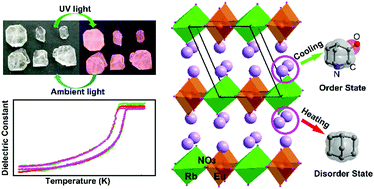A layered hybrid rare-earth double-perovskite-type molecule-based compound with electrical and optical response properties†
Abstract
A layered hybrid rare-earth double-perovskite-type molecule-based compound, (3HQ)4[RbEu(NO3)8] (3HQ = 3-quinuclidinone cation, 1), was synthesized. It was shown to undergo a reversible phase transition and switchable dielectric constant above room temperature (phase transition point Tc = 438 K). Single-crystal structure analyses at two temperatures revealed changes of the crystal lattice dynamics, namely an order–disorder transition of the organic cation and distortion of the anionic framework, to be the origin of the phase transition. Meanwhile, these changes prompted the occurrence of a dielectric transition between a “switch off” (low-dielectric) state and a “switch on” (high-dielectric) state, i.e., revealing the ability of 1 to switch between dielectric constant states. Moreover, a photoluminescence property of 1 under UV excitation was also identified. The otherwise colourless sample was shown when exposed to UV light to photoluminescently emit bright orange red light with a quantum efficiency (QE) yield of 20.53%. This finding of a hybrid rare-earth double perovskite displaying a prominent phase transition and photoluminescence is expected to expand the development of effective pathways for designing multifunctional smart stimuli-responsive materials.

- This article is part of the themed collection: Journal of Materials Chemistry C HOT Papers


 Please wait while we load your content...
Please wait while we load your content...